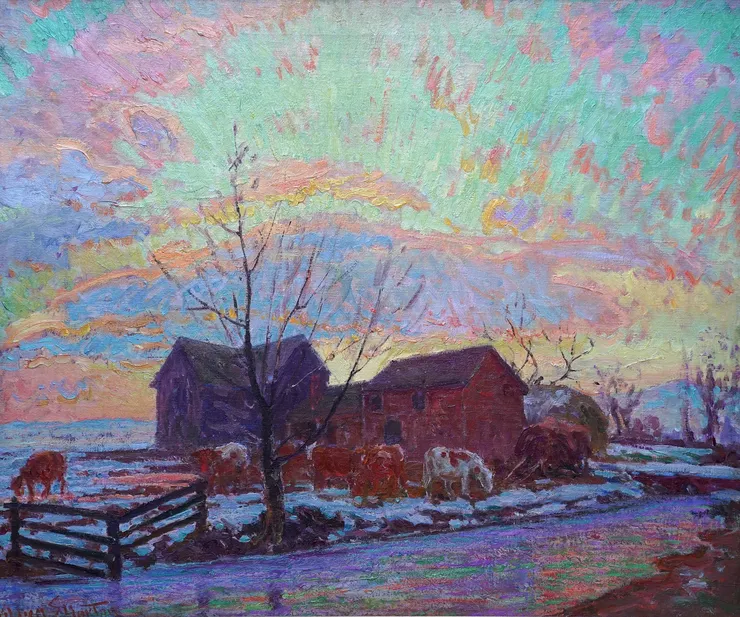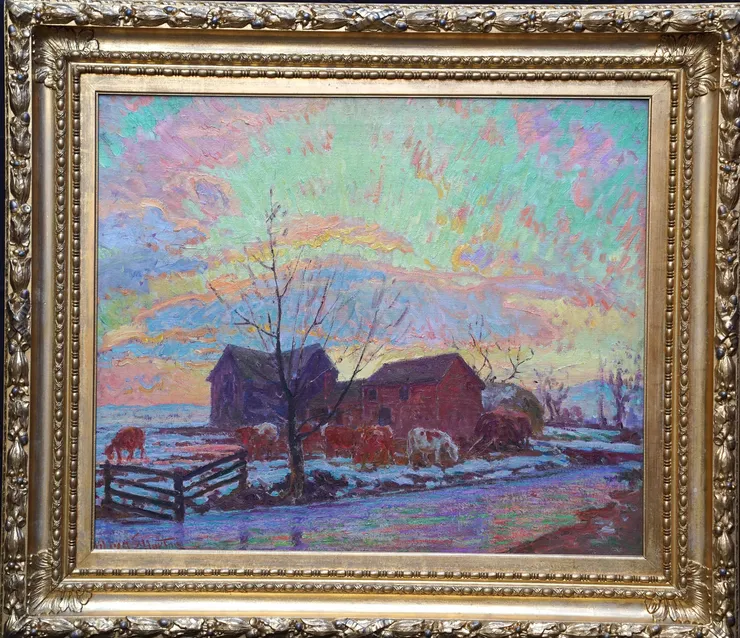William Samuel Horton (1865-1936)
| Artist Name | William Samuel Horton (1865-1936) |
|---|---|
| Title | Cattle in a Farm Landscape |
| Description | This stunning Impressionist farm landscape oil painting is by one of the leading American Impressionist artists, William Samuel Horton. Horton moved to England in1918 and travelled extensively in Europe and later Asia. His paintings show the influences of the French Impressionists as whilst studying in Paris Horton befriended and worked closely alongside some of the leading Impressionist artists including Whistler, Pissarro, Degas and Monet. Painted circa 1910, the composition is cattle in a snowy landscape in front of a farm. It is early morning and the sky is a blaze of colours, reflected in the water in the foreground. The sky absolutely steals the show with its vibrancy forming an arc over the darker buildings and cattle . The impressionistic brushwork is superb and this is an excellent example of Horton's work from that period and the influence of the French Impressionists. The painting has been exhibited at The Art Institute in Chicago as well French dealers. Signed lower left. |
| Provenance | Art Institute of Chicago labels verso. Doumaves Francaises. Service des Expositions Paris Galerie Charpentier. Label Verso. James Bourlet. Label verso. Wax seal stamp verso. |
| Medium | Oil on Canvas |
| Size | 30 x 25 inches |
| Frame | Housed in an ornate gilt frame, 36 inches by 31 inches, in good condition. |
| Condition | Good condition. |
| Biography | William Samuel Horton (1865-1936) is considered by critics to be one of the leading members of American Impressionism, best-known for his Monetesque sunsets and sunrises, Swiss Alpine landscapes, New York skylines and Norwegian fjord scenes. W.S. Horton grew up in a wealthy family and left home in 1883 to study at the Art Institute of Chicago and the Art Students League of New York. In 1892, Horton married the New York debutante Carlotta Lorrie Gray and in 1893 they moved to Holland, later settling in Paris where Horton joined the Académie Julian art school. It was Paris that perhaps had the greatest influence on the artist’s stylistic development, as whilst studying in the French capital he befriended and worked closely alongside some of the leading Impressionist artists including Whistler, Pissarro, Degas and Monet. In 1918 Horton moved to England, continuing to travel often to Europe, painting and sketching scenes in Switzerland, France and Italy. During his travels the artist developed his own Impressionist style, and like Monet focussed on the effects of light on colour, atmosphere, form, shadow and shapes. Like the founding Impressionist, Horton painted the same motif or scene at different times of the day, studying the effect of the light. Examples include his 1934 dramatic sunsets and sunrises over the coastal fjords, planes and mountains of Norway, his recognisable cityscapes of the New York skyline, most notably of the Ritz and Heckscher towers (1924-1930) and his snowy landscapes of the Swiss Alps. In 1935 the artist travelled to Asia (China, Singapore, India and Indonesia), continuing to paint and sketch, including on board ships. W.S. Horton and his wife were relatively wealthy during their lifetime, selling few of his artworks. When Horton died in 1936 he left over 1000 oils, pastels and drawings to their son William Gray, who organised a retrospective exhibition of his father’s work at the Galerie Charpentier, Paris in 1939, which included an appreciation text by the famous art critic Louis Vauxcelles. Horton’s works can be found in the permanent collections of the Musée d'Orsay, Paris, the Musée National d'Art Moderne, Paris and the National Museum, Stockholm. |
| Price | £16000 |

